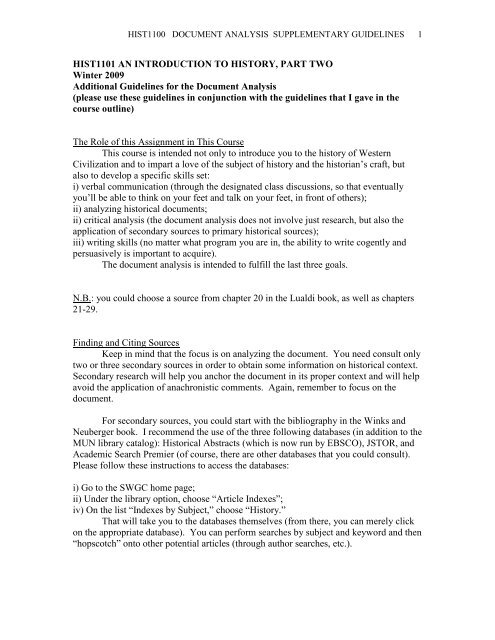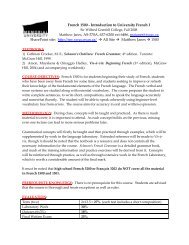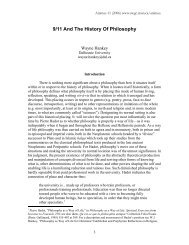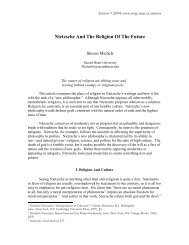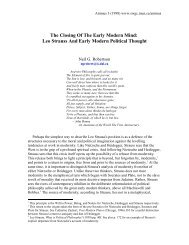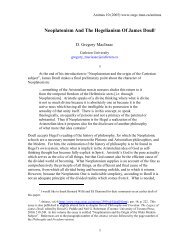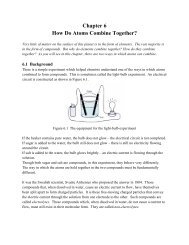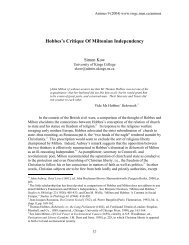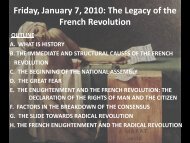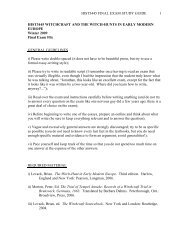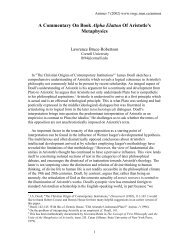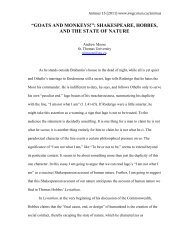HIST1101 AN INTRODUCTION TO HISTORY, PART TWO
HIST1101 AN INTRODUCTION TO HISTORY, PART TWO
HIST1101 AN INTRODUCTION TO HISTORY, PART TWO
Create successful ePaper yourself
Turn your PDF publications into a flip-book with our unique Google optimized e-Paper software.
HIST1100 DOCUMENT <strong>AN</strong>ALYSIS SUPPLEMENTARY GUIDELINES 1<br />
<strong>HIST1101</strong> <strong>AN</strong> <strong>INTRODUCTION</strong> <strong>TO</strong> HIS<strong>TO</strong>RY, <strong>PART</strong> <strong>TWO</strong><br />
Winter 2009<br />
Additional Guidelines for the Document Analysis<br />
(please use these guidelines in conjunction with the guidelines that I gave in the<br />
course outline)<br />
The Role of this Assignment in This Course<br />
This course is intended not only to introduce you to the history of Western<br />
Civilization and to impart a love of the subject of history and the historian’s craft, but<br />
also to develop a specific skills set:<br />
i) verbal communication (through the designated class discussions, so that eventually<br />
you’ll be able to think on your feet and talk on your feet, in front of others);<br />
ii) analyzing historical documents;<br />
ii) critical analysis (the document analysis does not involve just research, but also the<br />
application of secondary sources to primary historical sources);<br />
iii) writing skills (no matter what program you are in, the ability to write cogently and<br />
persuasively is important to acquire).<br />
The document analysis is intended to fulfill the last three goals.<br />
N.B.: you could choose a source from chapter 20 in the Lualdi book, as well as chapters<br />
21-29.<br />
Finding and Citing Sources<br />
Keep in mind that the focus is on analyzing the document. You need consult only<br />
two or three secondary sources in order to obtain some information on historical context.<br />
Secondary research will help you anchor the document in its proper context and will help<br />
avoid the application of anachronistic comments. Again, remember to focus on the<br />
document.<br />
For secondary sources, you could start with the bibliography in the Winks and<br />
Neuberger book. I recommend the use of the three following databases (in addition to the<br />
MUN library catalog): Historical Abstracts (which is now run by EBSCO), JS<strong>TO</strong>R, and<br />
Academic Search Premier (of course, there are other databases that you could consult).<br />
Please follow these instructions to access the databases:<br />
i) Go to the SWGC home page;<br />
ii) Under the library option, choose “Article Indexes”;<br />
iv) On the list “Indexes by Subject,” choose “History.”<br />
That will take you to the databases themselves (from there, you can merely click<br />
on the appropriate database). You can perform searches by subject and keyword and then<br />
“hopscotch” onto other potential articles (through author searches, etc.).
HIST1100 DOCUMENT <strong>AN</strong>ALYSIS SUPPLEMENTARY GUIDELINES 2<br />
You will notice that, often, EBSCO does not tell you exactly where the materials<br />
are located in the MUN Library system. If there is no direct link to the scanned article<br />
itself, you will need to determine if the MUN library carries the journal in which the<br />
article is cited. JS<strong>TO</strong>R and Academic Search Premier have links to the scanned versions<br />
of the articles themselves (particularly JS<strong>TO</strong>R).<br />
Be sure to avoid the excessive use of encyclopedias and general-level textbooks,<br />
and be very careful with material found on websites (those websites associated with<br />
universities or museums are usually reliable; but stay clear of “wacko websites” like<br />
those that have a swastika next to the title). Please do not use more than one website in<br />
your assignment.<br />
Please use an accepted method of citing sources in Historical Studies when drafting<br />
the bibliography, as opposed to the format used in the bibliographical aid (for more<br />
details, consult the Chicago Style Manual, available in the Ferriss Hodgett Library).<br />
Note the following example of correct bibliographical references for an article,<br />
using the Chicago Style Manual format:<br />
i) For an article:<br />
Peterson, David S. “Out of the Margins: Religion and the Church in Renaissance Italy.”<br />
Renaissance Quarterly 53, no. 3 (2000): 835-879.<br />
ii) For a book:<br />
King, Margaret. The Death of the Child Valerio Marcello. Chicago: University of<br />
Chicago Press, 1994.<br />
Remember as well that the databases may have different ways of presenting<br />
bibliographical references. Be sure to adapt the references accordingly to the format<br />
required for this assignment.<br />
The Introduction<br />
The introduction should be about three-quarters of a page in length. The<br />
introduction will indicate the documents chosen, outline the essay’s orientation and<br />
approach, and provide a thesis statement as well as a clear idea of the essay’s structure.<br />
Don’t forget to include the annotated bibliography!<br />
Paragraph Construction<br />
The body of the essay should be composed of a number of separate ideas––one<br />
idea per paragraph––that are linked to the thesis statement in the introduction. Each<br />
paragraph typically is linked to the preceding paragraph and to the one following it<br />
through the use of linking words and phrases like “however,” “in addition,”<br />
“furthermore,” and so on. Each paragraph should not be more than three-quarters of a<br />
page in length (otherwise, the effectiveness of your point is lost in a sea of indigestible<br />
information).
HIST1100 DOCUMENT <strong>AN</strong>ALYSIS SUPPLEMENTARY GUIDELINES 3<br />
Treat each paragraph as a kind of miniature essay. The first sentence is the<br />
introductory statement that conveys what the paragraph will address. The following<br />
sentences expand and develop that statement. The final sentence makes a final point and<br />
anticipates the next paragraph. It is important to link each sentence carefully within each<br />
paragraph, so that the argument flows from one sentence to the next.<br />
Before writing a paragraph, quickly jot down on paper what the paragraph should<br />
contain. That will help you organize your thoughts more carefully and will make the<br />
process of writing more enjoyable (like painting!). Then, after you have written that<br />
paragraph, give it a quick read to ensure that it makes sense. More detailed editing can<br />
come later.<br />
Finally, vary the length of your sentences for greater effect. Use short concise<br />
statements to hammer home a point, and longer statements for descriptive detail.<br />
Excessive strings of long sentences that are overloaded with subordinate and relative<br />
clauses tend to exhaust the reader.<br />
Editing<br />
Please do not rely on MS Word to edit your paper. Bill Gates cannot express<br />
what you need to say and how you want to say it (and the grammar checking function on<br />
that program is not foolproof). In fact, a good paper will emerge only after having been<br />
edited several times. Even a sharp eye cannot catch all the grammar mistakes or<br />
problems with just one reading. That means reading over every paragraph to look not<br />
only for spelling errors and minor grammar mistakes, but also for faulty paragraph<br />
construction, punctuation problems, poor development of an argument, and awkward<br />
phrasing.<br />
Plagiarism<br />
Please be careful when citing and using sources. Remember that unless you are<br />
putting a phrase or sentence in quotation marks, you must put the author’s words into<br />
your own words (even if you insert a footnote for the sentence). By showing that you can<br />
paraphrase, you convey the idea that you understand what the author is saying well<br />
enough to explain it to someone else. Besides, perhaps you could explain it even better!<br />
Other Points to Remember<br />
i) Be sure that the introduction has a thesis statement, one that is clear, specific, relevant,<br />
and cohesive; this statement also must accurately reflects the message and argument of<br />
your paper;<br />
ii) The essay must contain documentation (footnotes or endnotes);<br />
iii) Please remember to make backup copies as you type the paper (only morons do not<br />
back up their work); likewise, hold onto that backup copy after you submit the paper; and<br />
iv) Please (what the hey! I must’ve said “please” about a hundred times in this handout!)<br />
; where was I? Oh yes, please do not slip the essay underneath my door.<br />
Let me stress that if you have any questions, feel free to send me an e-mail or<br />
come to see me during my office hours. I would be more than happy to look at your<br />
paper’s introduction, parts of the body of the paper, and its overall argument. Good luck!


